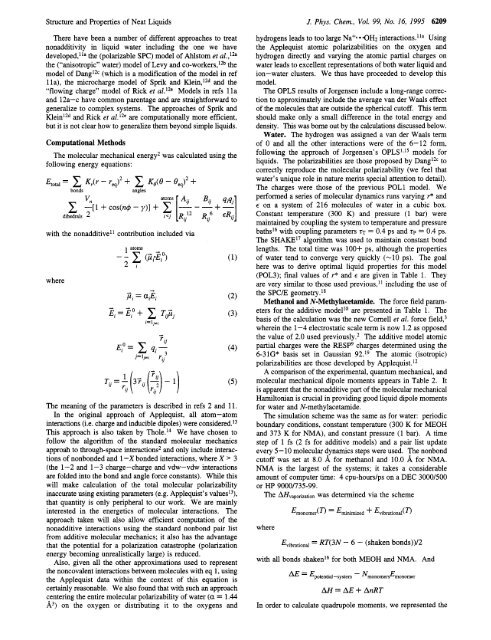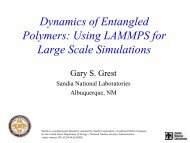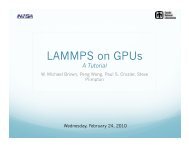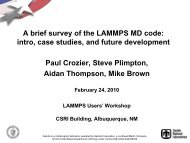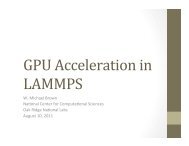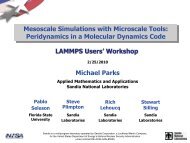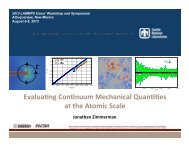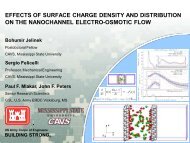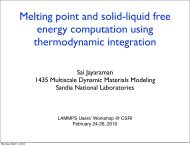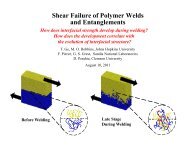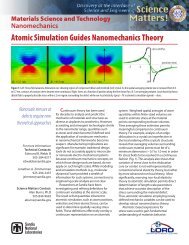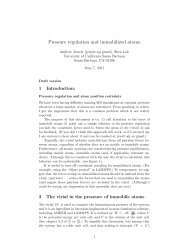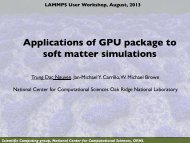Structure and Properties of Neat Liquids Using Nonadditive ...
Structure and Properties of Neat Liquids Using Nonadditive ...
Structure and Properties of Neat Liquids Using Nonadditive ...
Create successful ePaper yourself
Turn your PDF publications into a flip-book with our unique Google optimized e-Paper software.
<strong>Structure</strong> <strong>and</strong> <strong>Properties</strong> <strong>of</strong> <strong>Neat</strong> <strong>Liquids</strong><br />
There have been a number <strong>of</strong> different approaches to treat<br />
nonadditivity in liquid water including the one we have<br />
developed,lla the (polarizable SPC) model <strong>of</strong> Ahlstom et<br />
the (“anisotropic” water) model <strong>of</strong> Levy <strong>and</strong> co-workers,12b the<br />
model <strong>of</strong> DanglZC (which is a modification <strong>of</strong> the model in ref<br />
lla), the microcharge model <strong>of</strong> Sprik <strong>and</strong> Klein,lZd <strong>and</strong> the<br />
“flowing charge” model <strong>of</strong> Rick et ~ 1 . Models l ~ ~ in refs lla<br />
<strong>and</strong> 12a-c have common parentage <strong>and</strong> are straightforward to<br />
generalize to complex systems. The approaches <strong>of</strong> Sprik <strong>and</strong><br />
KleinlZd <strong>and</strong> Rick et ~ 1 . are ’ ~ computationally ~<br />
more efficient,<br />
but it is not clear how to generalize them beyond simple liquids.<br />
Computational Methods<br />
The molecular mechanical energy2 was calculated using the<br />
following energy equations:<br />
with the nonadditive’ contribution included via<br />
where<br />
1 atoms<br />
i=lj+i<br />
The meaning <strong>of</strong> the parameters is described in refs 2 <strong>and</strong> 11.<br />
In the original approach <strong>of</strong> Applequist, all atom-atom<br />
interactions (i.e. charge <strong>and</strong> inducible dipoles) were ~0nsidered.I~<br />
This approach is also taken by Th01e.l~ We have chosen to<br />
follow the algorithm <strong>of</strong> the st<strong>and</strong>ard molecular mechanics<br />
approah to through-space interactions2 <strong>and</strong> only include interactions<br />
<strong>of</strong> nonbonded <strong>and</strong> 1 -X bonded interactions, where X > 3<br />
(the 1-2 <strong>and</strong> 1-3 charge-charge <strong>and</strong> vdw-vdw interactions<br />
are folded into the bond <strong>and</strong> angle force constants). While this<br />
will make calculation <strong>of</strong> the total molecular polarizability<br />
inaccurate using existing parameters (e.g. Applequist’s values13),<br />
that quantity is only peripheral to our work. We are mainly<br />
interested in the energetics <strong>of</strong> molecular interactions. The<br />
approach taken will also allow efficient computation <strong>of</strong> the<br />
nonadditive interactions using the st<strong>and</strong>ard nonbond pair list<br />
from additive molecular mechanics; it also has the advantage<br />
that the potential for a polarization catastrophe (polarization<br />
energy becoming unrealistically large) is reduced.<br />
Also, given all the other approximations used to represent<br />
the noncovalent interactions between molecules with eq 1, using<br />
the Applequist data within the context <strong>of</strong> this equation is<br />
certainly reasonable. We also found that with such an approach<br />
centering the entire molecular polarizability <strong>of</strong> water (a = 1.44<br />
A3) on the oxygen or distributing it to the oxygens <strong>and</strong><br />
(4)<br />
(5)<br />
J. Phys. Chem., Vol. 99, No. 16, 1995 6209<br />
hydrogens leads to too large Na+* .OH2 interactions.lla <strong>Using</strong><br />
the Applequist atomic polarizabilities on the oxygen <strong>and</strong><br />
hydrogen directly <strong>and</strong> varying the atomic partial charges on<br />
water leads to excellent representations <strong>of</strong> both water liquid <strong>and</strong><br />
ion-water clusters. We thus have proceeded to develop this<br />
model.<br />
The OPLS results <strong>of</strong> Jorgensen include a long-range correction<br />
to approximately include the average van der Waals effect<br />
<strong>of</strong> the molecules that are outside the spherical cut<strong>of</strong>f. This term<br />
should make only a small difference in the total energy <strong>and</strong><br />
density. This was bome out by the calculations discussed below.<br />
Water. The hydrogen was assigned a van der Waals term<br />
<strong>of</strong> 0 <strong>and</strong> all the other interactions were <strong>of</strong> the 6-12 form,<br />
following the approach <strong>of</strong> Jorgensen’s OPLS1$15 models for<br />
liquids. The polarizabilities are those proposed by DanglZc to<br />
correctly reproduce the molecular polarizability (we feel that<br />
water’s unique role in nature merits special attention to detail).<br />
The charges were those <strong>of</strong> the previous POL1 model. We<br />
performed a series <strong>of</strong> molecular dynamics runs varying r* <strong>and</strong><br />
E on a system <strong>of</strong> 216 molecules <strong>of</strong> water in a cubic box.<br />
Constant temperature (300 K) <strong>and</strong> pressure (1 bar) were<br />
maintained by coupling the system to temperature <strong>and</strong> pressure<br />
baths16 with coupling parameters t~ = 0.4 ps <strong>and</strong> ZP = 0.4 ps.<br />
The SHAKE” algorithm was used to maintain constant bond<br />
lengths. The total time was 100+ ps, although the properties<br />
<strong>of</strong> water tend to converge very quickly (-10 ps). The goal<br />
here was to derive optimal liquid properties for this model<br />
(POL3); final values <strong>of</strong> r* <strong>and</strong> E are given in Table 1. They<br />
are very similar to those used previous,” including the use <strong>of</strong><br />
the SPC/E geometry.18<br />
Methanol <strong>and</strong> N-Methylacetamide. The force field parameters<br />
for the additive modello are presented in Table 1. The<br />
basis <strong>of</strong> the calculation was the new Come11 et al. force field,3<br />
wherein the 1-4 electrostatic scale term is now 1.2 as opposed<br />
the value <strong>of</strong> 2.0 used previously.2 The additive model atomic<br />
partial charges were the RESP9 charges determined using the<br />
6-31G* basis set in Gaussian 92.19 The atomic (isotropic)<br />
polarizabilities are those developed by Applequist. l2<br />
A comparison <strong>of</strong> the experimental, quantum mechanical, <strong>and</strong><br />
molecular mechanical dipole moments appears in Table 2. It<br />
is apparent that the nonadditive part <strong>of</strong> the molecular mechanical<br />
Hamiltonian is crucial in providing good liquid dipole moments<br />
for water <strong>and</strong> N-methylacetamide.<br />
The simulation scheme was the same as for water: periodic<br />
boundary conditions, constant temperature (300 K for MEOH<br />
<strong>and</strong> 373 K for NMA), <strong>and</strong> constant pressure (1 bar). A time<br />
step <strong>of</strong> 1 fs (2 fs for additive models) <strong>and</strong> a pair list update<br />
every 5-10 molecular dynamics steps were used. The nonbond<br />
cut<strong>of</strong>f was set at 8.0 A for methanol <strong>and</strong> 10.0 A for NMA.<br />
NMA is the largest <strong>of</strong> the systems; it takes a considerable<br />
amount <strong>of</strong> computer time: 4 cpu-hours/ps on a DEC 3000/500<br />
or HP 9000/735-99.<br />
The AHvapo~zation was determined via the scheme<br />
where<br />
Emonomer(n = Eminhized + Evibrational(n<br />
Evibrational = RT(3N - 6 - (shaken bonds))/2<br />
with all bonds shaken16 for both MEOH <strong>and</strong> NMA. And<br />
AE = ‘potential-system<br />
AH = AE + AnRT<br />
-<br />
NmonomersEmonomer<br />
In order to calculate quadrupole moments, we represented the


